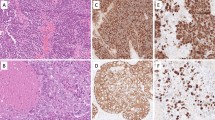Summary.
Neuroendocrine tumors are rare and slowly progressing malignancies developing predominantly in the gastrointestinal tract. Often symptoms caused by excessive hormone production lead to diagnosis, especially when active metabolites are released from hepatic metastases to reach the systemic circulation before they are inactivated in the liver. Preoperative diagnosis of specific tumors relies on demonstration of the respective hormones in serum or urine rather than on histological diagnosis. Localization of primaries or their metastases can be accomplished by CT-AP, somatostatin receptor scintigraphy, SPECT or PET studies with high sensitivity. At the time of diagnosis more than 60 % of tumors have already spread to the liver. Potentially curative resection of liver metastases can achieve 5-year survival rates of more than 60 %. Since excess hormone production may be incapacitating and even life-threatening, effective palliation is highly important. Five-year survival following palliative liver resection was calculated to be almost 40 %. Palliative liver resection may therefore be considered an alternative to liver transplantation with 5-year survival of 34 % in a collected series. If liver resection is not possible, at least temporary palliation of symptoms and retardation of tumor growth can effectively be achieved with somatostatin analogues.
Zusammenfassung.
Neuroendokrine Tumoren entstehen vorwiegend im Gastrointestinaltrakt und sind vergleichsweise selten. Sie zeichnen sich durch langsames Wachstum aus und werden oft erst durch ihre spezifischen hormonellen Stoffwechselprodukte symptomatisch, wenn bei entsprechend großer hormonproduzierender Tumormasse aus dem portalen Stromgebiet anflutende stoffwechselaktive Metaboliten in der Leber nicht mehr ausreichend abgebaut werden können. Das gleiche gilt bei der sehr häufigen Metastasierung in die Leber selbst, wenn hormonell aktive Substanzen den systemischen Kreislauf erreichen bevor sie abgebaut werden können. Die präoperative artspezifische Diagnostik beruht auf dem Nachweis der jeweiligen Hormone in Serum oder Urin und weniger auf der histologischen Sicherung. Die Lokalisationsdiagnostik erreicht durch spezielle Untersuchungsverfahren wie CT-AP, Somatostatinrezeptorszintigraphie, SPECT und PET eine sehr hohe Sensitivität. Über 60 % der Patienten haben bei Erstdiagnose bereits Lebermetastasen. Bei potentiell kurativer Resektion der Lebermetastasen werden 5-Jahres-Überlebensraten von über 60 % erreicht. Wegen der starken Beeinträchtigung des Allgemeinbefindens durch die – möglicherweise sogar lebensbedrohliche – hormonelle Überproduktion kommt auch palliativen Maßnahmen eine sehr große Bedeutung zu. Nach palliativer Leberresektion beträgt die 5-Jahres-Überlebensrate fast 40 %. Damit kann die palliative Leberresektion als Alternative zur Transplantation mit einer 5-Jahres-Überlebensrate von 34 % in einer Sammelstatistik erwogen werden. Falls eine Leberresektion nicht möglich ist, kann eine wirksame Palliation der Symptome und eine Wachstumsverlangsamung durch Somatostatinanaloga zumindest vorübergehend erreicht werden.
Similar content being viewed by others
Author information
Authors and Affiliations
Rights and permissions
About this article
Cite this article
Lehnert, T., Knaebel, HP. Diagnostik und Therapie von Lebermetastasen neuroendokriner Tumoren. Chirurg 68, 122–131 (1997). https://doi.org/10.1007/s001040050161
Issue Date:
DOI: https://doi.org/10.1007/s001040050161




